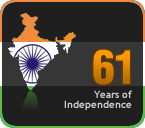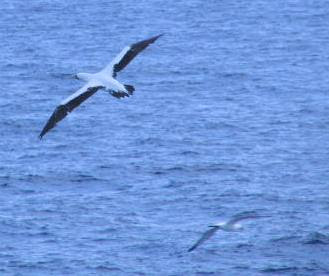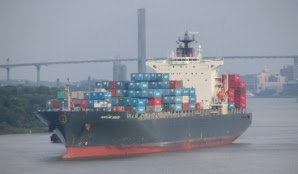
The Carribians : 13 16 N, 069 56 W, Spd 13 Kts
Let's go back to the container ship Tokyo Express that we had seen a couple of posts back. Seen in the picture above are the flags on the main mast above the Wheelhouse / Bridge. On the extreme right we can see the Smoke stack or the funnel of the ship
painted Orange & then the three windows of the Bridge. On most ships, the flags have to be hoisted by going above the Bridge, to a deck called the Monkey Island. But on Tokyo express the flag halyards seem to be tied to the Bridge deck on the area
outside the enclosed bridge. This area is called the "Bridge Wings".
International Flag Etiquette is very clear on the method of hoisting flags on the merchant ships. The last time we saw Tokyo express, I had shown you the Jack staff where the Flag of registry (Germany in this case) was hoisted. It is on the main mast
that the rest of the flags are hoisted.
The flag on the Extreme Starboard of the main mast is always the country of visit. As the snap was taken in Savannah, we have the star spangled banner fluttering in a northerly breeze. Some countries like Saudi Arabia want their flag hoisted on the
forward mast.
The flag after the Visiting countries flag is generally the house flag. A house flag is the flag of the owner. In this case they have put the house flag as the third from the stbd. It is the Orange & blue flag. It's a common error that the flag
hoisting seamen do, but not serious enough as the visiting country officials are not bothered.
Back in the old days, when communication between ships was limited, each alphabet was assigned a flag & each alphabet was given a meaning. The full list of the Signals can be obtained in the International code of Signals that is an standard
publication.
The second flag is one such flag & is the "H" or "Hotel" flag & is meant to represent "I have pilot on board." It is very unlikely that a vessel tied up at berth would actually have a pilot on board, but due to the short port stays with the container
ships, the flags are often kept up.
The Last Red colored flag is the "B" or the "Bravo" flag & is meant to represent "I am loading or discharging dangerous cargo". In all likelihood, every port of discharge would have a couple of containers of dangerous cargoes. So this must be another
flag that the seaman must have standard instructions to put up.


































